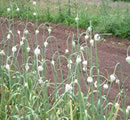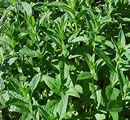|
Hibiscus
A
refreshing and very popular beverage can be made by boiling
the dried flowers, sweetening it with sugar.
The flowers contain gossypetin, anthocyanin, and the glycoside
hibiscin. These have diuretic and choleretic effects, decreasing
the viscosity of the blood, reducing blood pressure and stimulating
intestinal peristalsis]. The ripe calyces are diuretic and
antiscorbutic. The succulent calyx, boiled in water, is used
as a drink in the treatment of bilious attacks.
| * Move
the mouse over a product's name to see indications |
SEASON |
Parsley

One
of the richest sources of vitamin C; use as a diuretic;
to stimulate the menstrual process; to ease flatulence
and colic pains.
Garlic

A
herb that have universal usage & recognition; its
daily usage aids and supports the body in ways no other
does. It is one of the most effective anti-microbial
plants available. Use for infections of the lungs such
as chronic bronchitis, respiratory catarrh, recurrent
colds and influenza, cough & bronchitis asthma;
reduces high cholesterol levels, to improve the quality
of the cardiovascular system & to help lower blood
sugar levels; use for conditions of severe digestive
disorders promotes all round body health and protection.
Product
Spearmint

Digestive
disorders, flatulence, Used in all healing applications;
sharpening mental powers; for protection while asleep.
Lemongrass
Pleaseant,
refreshing herbal beverage
Mild
astringent, stomach tonic
Peppermint
Good
for children. Peppermint is used for intestinal colic,
flatulent dyspepsia, indigestion, to stimulate bile
and digestive secretion, to allay feelings of nausea
and the desire to vomit so is good in pregnancy and
travel sickness; to help relieve ulcerative colitis
and Crohn’s disease; fevers, colds, influenza;
anxiety, tension, hysteria; painful periods and associated
tension; soak a pad in the infusion to cool inflamed
joints, rheumatism or neuralgia; put a few fresh leaves
in boiling water and inhale to ease nasal congestion.
Basil
Rub
fresh leaves on insect bites; combine with a little
motherwort and drink an infusion after childbirth to
prevent a retained placenta; combine with skullcap for
nervous conditions; combine with hyssop for coughs and
bronchitis; use an inhalation for head colds; add 5-10
drops of oil to a bath for nervous exhaustion, mental
fatigue or melancholy.
|
Latin
Name
|
Start |
End |
|

|
Matricaria
recutita
Calendula
One
of the best herbs for treating local skin problems; apply
a pad soaked in an infusion to slow healing wounds, bruises,
strains or varicose ulcers; apply a cream for dry eczema,
sore nipples in breast feeding, scalds, sunburn; internally
it acts against digestive inflammation or ulcers, inflammation
of the esophagus; use the tincture for gall bladder problems,
stagnant liver problems, sluggish digestion; helps delayed
menses and period pain; use an infused oil on chilblains,
hemorrhoids, broken capillaries.
|
Jan |
Apr |
 |
Foeniculum vulgare
|
May |
Jun |
 |
Calendula
officinalis |
Jan |
Apr |
 |
Menthae
spicata |
Apr |
Oct |

|
Hibiscus
sabdariffa |
Oct
|
Dec |
|  |
Cymbopogon
citratus |
Jun |
Oct |
 |
Mentha
piperita |
Jun |
Oct |
 |
Ocimum
basilicum |
Jul |
Oct |
Chamomile
An
excellent, gentle sedative, useful and safe for fussy, colicky,
restless children; anxiety, insomnia; indigestion, gastritis,
irritable bowel syndrome, flatulence, poor appetite; use as
a mouthwash for gingivitis and a gargle for sore throat; use
as an eyewash for conjunctivitis or strained eyes; use as an
ointment for insect bites, wounds, itching eczema, anal or vulval
irritation; use as an inhalation for phlegm, hay fever, asthma,
bronchitis.
Fennel
Fennel
tea, formerly also employed as a carminative, is made by pouring
half a pint of boiling water on a teaspoonful of bruised Fennel
seeds.
Syrup
prepared from Fennel juice was formerly given for chronic coughs.
It
is one of the plants which is said to be disliked by fleas,
and powdered Fennel has the effect of driving away fleas from
kennels and stables. The plant gives off ozone most readily.
The
tender leaves are often used for garnishes and to add flavour
to salads, also added finely chopped, to sauces served with
puddings. Roman bakers are said to put the herb under their
loaves in the oven to make the bread taste agreeably.
|
|
|
